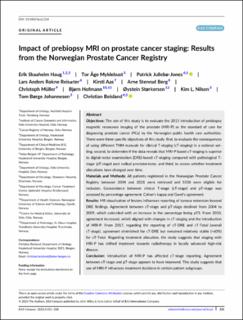| dc.contributor.author | Haug, Erik Skaaheim | |
| dc.contributor.author | Myklebust, Tor Åge | |
| dc.contributor.author | Juliebø-Jones, Patrick | |
| dc.contributor.author | Reisæter, Lars Anders Rokne | |
| dc.contributor.author | Aas, Kirsti | |
| dc.contributor.author | Berg, Arne Stenrud | |
| dc.contributor.author | Muller, Christoph Rainer | |
| dc.contributor.author | Hofmann, Bjørn Morten | |
| dc.contributor.author | Størkersen, Øystein | |
| dc.contributor.author | Nilsen, Kim L. | |
| dc.contributor.author | Johannessen, Tom Børge | |
| dc.contributor.author | Beisland, Christian | |
| dc.date.accessioned | 2023-08-15T11:50:10Z | |
| dc.date.available | 2023-08-15T11:50:10Z | |
| dc.date.created | 2023-01-17T14:54:55Z | |
| dc.date.issued | 2023 | |
| dc.identifier.issn | 1464-4096 | |
| dc.identifier.uri | https://hdl.handle.net/11250/3084141 | |
| dc.description.abstract | Objectives
The aim of this study is to evaluate the 2015 introduction of prebiopsy magnetic resonance imaging of the prostate (MRI-P) as the standard of care for diagnosing prostate cancer (PCa) by the Norwegian public health care authorities. There were three specific objectives of this study: first, to evaluate the consequences of using different TNM manuals for clinical T-staging (cT-staging) in a national setting; second, to determine if the data reveals that MRI-P based cT-staging is superior to digital rectal examination (DRE)-based cT-staging compared with pathological T-stage (pT-stage) post radical prostatectomy; and third, to assess whether treatment allocations have changed over time.
Materials and Methods
All patients registered in the Norwegian Prostate Cancer Registry between 2004 and 2021 were retrieved and 5538 were eligible for inclusion. Concordance between clinical T-stage (cT-stage) and pT-stage was assessed by percentage agreement, Cohen's kappa and Gwet's agreement.
Results
MR visualisation of lesions influences reporting of tumour extension beyond DRE findings. Agreement between cT-stage and pT-stage declined from 2004 to 2009, which coincided with an increase in the percentage being pT3. From 2010, agreement increased, which aligned with changes in cT-staging and the introduction of MRI-P. From 2017, regarding the reporting of cT-DRE and cT-Total (overall cT-stage), agreement diminished for cT-DRE but remained relatively stable (>60%) for cT-Total. Regarding treatment allocation, the study suggests that staging with MRI-P has shifted treatment towards radiotherapy in locally advanced high-risk disease.
Conclusion
Introduction of MRI-P has affected cT-stage reporting. Agreement between cT-stage and pT-stage appears to have improved. This study suggests that use of MRI-P influences treatment decisions in certain patient subgroups. | en_US |
| dc.language.iso | eng | en_US |
| dc.publisher | Wiley | en_US |
| dc.rights | Navngivelse 4.0 Internasjonal | * |
| dc.rights.uri | http://creativecommons.org/licenses/by/4.0/deed.no | * |
| dc.title | Impact of prebiopsy MRI on prostate cancer staging: Results from the Norwegian Prostate Cancer Registry | en_US |
| dc.type | Journal article | en_US |
| dc.type | Peer reviewed | en_US |
| dc.description.version | publishedVersion | en_US |
| dc.rights.holder | Copyright 2023 The Author(s) | en_US |
| cristin.ispublished | true | |
| cristin.fulltext | original | |
| cristin.qualitycode | 2 | |
| dc.identifier.doi | 10.1002/bco2.214 | |
| dc.identifier.cristin | 2108739 | |
| dc.source.journal | BJU International | en_US |
| dc.source.pagenumber | 331-338 | en_US |
| dc.identifier.citation | BJU International. 2023, 4 (3), 331-338. | en_US |
| dc.source.volume | 4 | en_US |
| dc.source.issue | 3 | en_US |

